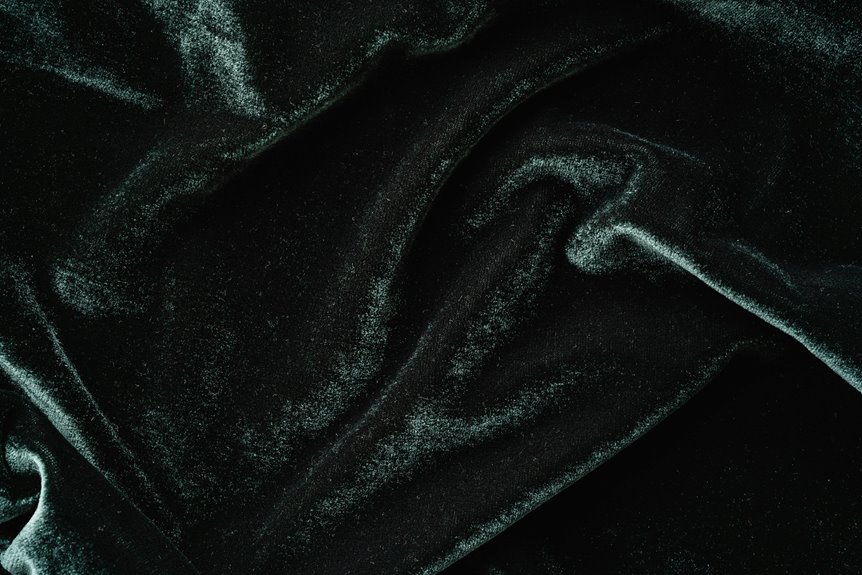Khadi silk is a hand-spun, handwoven fabric with roots in India’s rich tradition and sustainability. Unlike regular silk made by machines, khadi silk involves slow, eco-friendly craftsmanship using a charkha and manual loom, giving it a slightly coarser, stronger texture with unique irregularities. You’ll appreciate its natural sheen, breathability, and cultural significance. If you want to explore its weaving process, environmental benefits, and styling tips, there’s much more to uncover about this remarkable fabric.
Table of Contents
Key Takeaways
- Khadi silk is hand-spun and handwoven on traditional looms, emphasizing artisanal craftsmanship and sustainability.
- Unlike regular silk, khadi silk has a slightly rougher texture and unique irregularities from manual weaving.
- It uses natural dyes and eco-friendly processes, minimizing pollution and supporting rural artisans.
- Khadi silk is more durable due to tightly twisted fibers and the slow, careful weaving method.
- Authentic pieces bear KVIC certification and feature a distinct handmade feel not found in machine-made silk.
The History and Origin of Khadi Silk
Khadi silk carries a rich legacy that dates back centuries in India. When you explore its history, you’ll find it deeply intertwined with India’s struggle for independence.
Mahatma Gandhi championed khadi as a symbol of self-reliance and resistance against British colonial rule. Unlike factory-made fabrics, khadi silk was hand-spun and handwoven, emphasizing simplicity and sustainability.
Khadi silk embodies self-reliance and sustainability through its hand-spun, handwoven craftsmanship—an emblem of resistance.
You’ll notice that khadi silk’s story isn’t just about fabric; it’s about empowering rural artisans and preserving traditional craftsmanship. It’s this heritage that gives khadi silk its unique identity, setting it apart from regular silk.
When you wear or use khadi silk, you’re connecting with a tradition that values community, culture, and conscious creation, making it much more than just a textile.
The Traditional Weaving Process of Khadi Silk
Although the weaving process demands patience and skill, it’s what transforms raw silk into the distinctive fabric you recognize as khadi silk.
You start by hand-spinning the silk threads using a charkha, ensuring each strand is strong and even. Then, you carefully dye the threads with natural colors, preserving the fabric’s eco-friendly nature.
Once the threads dry, you set up the loom manually, aligning the warp and weft threads precisely. As you weave, you work methodically, pressing the shuttle through the threads to create a tight, consistent weave.
This hands-on approach means every piece of khadi silk carries the unique touch of its maker, blending tradition with craftsmanship in every thread you produce.
Characteristics That Distinguish Khadi Silk From Regular Silk
You’ll notice Khadi silk stands apart from regular silk in several key ways, starting with its fabric origin and the unique weaving techniques used.
When you touch Khadi silk, its texture feels distinct, often rougher yet more durable than typical silk.
Understanding these characteristics helps you appreciate why Khadi silk holds a special place in textile traditions.
Fabric Origin Differences
When you compare fabric origins, you’ll notice that khadi silk stands apart due to its hand-spun, handwoven process rooted in Indian tradition, unlike regular silk, which is often machine-made and industrially processed.
Khadi silk originates from locally sourced silk fibers spun by artisans, emphasizing sustainable, eco-friendly methods. In contrast, regular silk typically comes from silkworm cocoons processed on a large scale, prioritizing efficiency over artisanal value.
This difference in sourcing reflects the cultural significance of khadi silk, supporting rural communities and preserving heritage.
Meanwhile, regular silk’s industrial origin often results in uniformity but lacks the personal touch and authenticity you find in khadi silk.
Understanding these origins helps you appreciate khadi silk’s unique connection to craftsmanship and tradition compared to the mass-produced nature of regular silk.
Weaving Techniques Used
The hand-spun fibers of khadi silk set the stage for its distinctive weaving techniques, which differ considerably from those used in regular silk production.
When you weave khadi silk, you work on a traditional handloom, which demands skillful manual control. Unlike the power looms used in regular silk, these handlooms allow for subtle variations in thread tension and pattern, resulting in a unique, artisanal fabric.
You’ll notice the weaving process is slower, emphasizing craftsmanship over speed. This technique often produces a slightly uneven yet charming texture, reflecting the weaver’s touch.
In contrast, regular silk weaving relies on mechanized looms that produce uniform, smooth fabric quickly.
Texture and Durability
A key feature that sets khadi silk apart from regular silk lies in its texture and durability. When you touch khadi silk, you’ll notice its slightly rough, natural feel, unlike the smoothness of regular silk. This texture comes from hand-spun yarn and handwoven fabric, giving khadi silk a unique character. As for durability, khadi silk tends to be stronger due to the hand-spinning process, which tightly twists the fibers. Regular silk, while soft, is more delicate and prone to damage. Here’s a quick comparison:
| Feature | Khadi Silk | Regular Silk |
|---|---|---|
| Texture | Slightly coarse, natural | Smooth, glossy |
| Durability | Strong, long-lasting | Delicate, easily damaged |
| Feel | Earthy, rustic | Soft, luxurious |
Environmental Benefits of Choosing Khadi Silk
Although many fabrics claim eco-friendliness, khadi silk stands out by embracing traditional hand-spinning and weaving techniques that minimize energy use and pollution.
When you choose khadi silk, you support a process that avoids heavy machinery and reduces carbon emissions. The natural fibers used in khadi silk are biodegradable, helping you reduce your environmental footprint.
Unlike synthetic fabrics, khadi silk doesn’t rely on harmful chemicals during production, so you’re not contributing to soil or water contamination.
Plus, because khadi silk is handwoven in small batches, it generates less waste compared to mass-produced textiles.
The Role of Artisans in Khadi Silk Production
When you admire khadi silk’s unique texture and quality, you’re also appreciating the skilled hands of artisans who dedicate hours to each piece. These artisans spin, dye, and weave the silk using traditional methods passed down through generations. Their craftsmanship guarantees each fabric is distinct, with natural variations that make khadi silk special.
| Step | Artisan’s Role | Tools Used |
|---|---|---|
| Spinning | Hand-spinning silk yarn | Charkha (spinning wheel) |
| Dyeing | Applying natural colors | Dye vats, brushes |
| Weaving | Interlacing threads | Handloom |
| Quality Check | Inspecting fabric | Magnifying glass |
| Finishing | Trimming and polishing | Scissors, irons |
You can see how these artisans’ efforts shape khadi silk’s authenticity and charm.
Common Uses and Styling Tips for Khadi Silk
You can easily incorporate Khadi silk into your everyday wardrobe with simple, comfortable pieces that still look elegant.
For festive occasions, pairing Khadi silk with bold accessories can make your outfit stand out.
Let’s explore how to style and accessorize Khadi silk to suit different events and moods.
Everyday Wear Ideas
Khadi silk offers countless options for everyday wear, combining comfort with elegance.
You can easily style a simple khadi silk kurta with jeans or leggings for a polished yet relaxed look. Pair it with minimal accessories to maintain its natural charm.
For work, a khadi silk shirt or blouse adds texture and breathability to your outfit, keeping you comfortable throughout busy days. Layer it with a lightweight jacket or cardigan for cooler weather.
Don’t hesitate to mix khadi silk with cotton or linen pieces to balance sophistication and ease. Its breathable fabric guarantees you stay fresh, while the subtle sheen elevates your style without feeling overdressed.
With khadi silk, you get practical, stylish options perfect for daily wear.
Festive Occasion Styling
Although festive occasions call for vibrant and luxurious attire, khadi silk stands out by offering a unique blend of tradition and sophistication.
You can wear khadi silk sarees or kurta sets to weddings, religious ceremonies, or cultural festivals, where its rich texture and natural sheen make a subtle yet elegant statement.
Choose deep, festive colors like maroon, emerald, or royal blue to complement the fabric’s earthy appeal. Pair your outfit with simple, clean lines to highlight khadi silk’s handcrafted charm without overwhelming it.
You’ll notice that khadi silk’s breathable nature keeps you comfortable during long celebrations.
Whether you opt for a classic drape or a contemporary cut, khadi silk guarantees you look graceful while honoring heritage in every festive moment.
Accessorizing Khadi Silk
Festive ensembles crafted from khadi silk offer a perfect canvas for thoughtful accessorizing. When you wear khadi silk, choose accessories that complement its natural texture and rich hues.
Opt for handcrafted jewelry—think oxidized silver or antique gold—to enhance its artisanal charm. You can pair it with simple stud earrings or bold statement pieces, depending on your mood.
A classic silk or cotton dupatta with subtle embroidery adds elegance without overpowering the fabric. Footwear like leather sandals or juttis highlight the traditional vibe.
For bags, go for handcrafted clutches or potlis that resonate with the fabric’s heritage. Remember, minimal yet meaningful accessories let khadi silk’s unique texture shine, creating a balanced and sophisticated look for any occasion.
How to Identify Authentic Khadi Silk Garments
When you’re shopping for Khadi silk garments, knowing how to spot the real deal can save you from costly mistakes.
First, check the texture—authentic Khadi silk feels slightly coarse yet smooth, reflecting its handwoven nature.
Look closely at the weave; genuine Khadi has irregularities that machine-made silk lacks.
Verify the label for a Khadi and Village Industries Commission (KVIC) mark, confirming authenticity.
You can also perform a small burn test on loose threads—real silk smells like burnt hair and leaves ash, while synthetic fibers smell like burning plastic.
Finally, trust your seller—buy from reputable sources or certified Khadi outlets to guarantee you get genuine fabric.
These steps help you confidently choose authentic Khadi silk, appreciating its unique craftsmanship.
Frequently Asked Questions
Can Khadi Silk Be Machine Washed or Does It Require Special Care?
When you machine wash khadi silk, it risks damage; instead, you should hand wash it gently. For example, a boutique owner advises delicate care to preserve texture and color, avoiding harsh detergents and hot water.
Is Khadi Silk Suitable for People With Sensitive Skin?
You’ll find khadi silk gentle and breathable, making it suitable for sensitive skin. Since it’s natural and handwoven, it usually causes less irritation. Still, test a small patch first to guarantee it agrees with your skin.
How Does the Cost of Khadi Silk Compare to Regular Silk?
Think of khadi silk as the artisanal cousin of regular silk; you’ll find its cost slightly higher due to handcrafted labor and eco-friendly methods. You’re paying for unique texture and ethical craftsmanship, not just fabric.
Are There Any Certifications to Guarantee Khadi Silk Authenticity?
You can look for the Khadi and Village Industries Commission (KVIC) certification to guarantee authenticity. This official mark guarantees the fabric is genuine khadi silk, woven traditionally and ethically, protecting your purchase from imitations.
Can Khadi Silk Be Blended With Other Fabrics?
You’d think blending khadi silk with other fabrics is as rare as finding a unicorn, but you can! It’s often mixed with cotton or wool to create unique textures and enhance durability while keeping its natural charm intact.
- Do Percale Sheets Soften? The Truth About Their Feel Over Time - July 14, 2025
- Supima Sheets Explained: Are They Sateen or Percale? - July 14, 2025
- Are Boll and Branch Sheets Percale? a Deep Dive Into Their Weave - July 14, 2025







